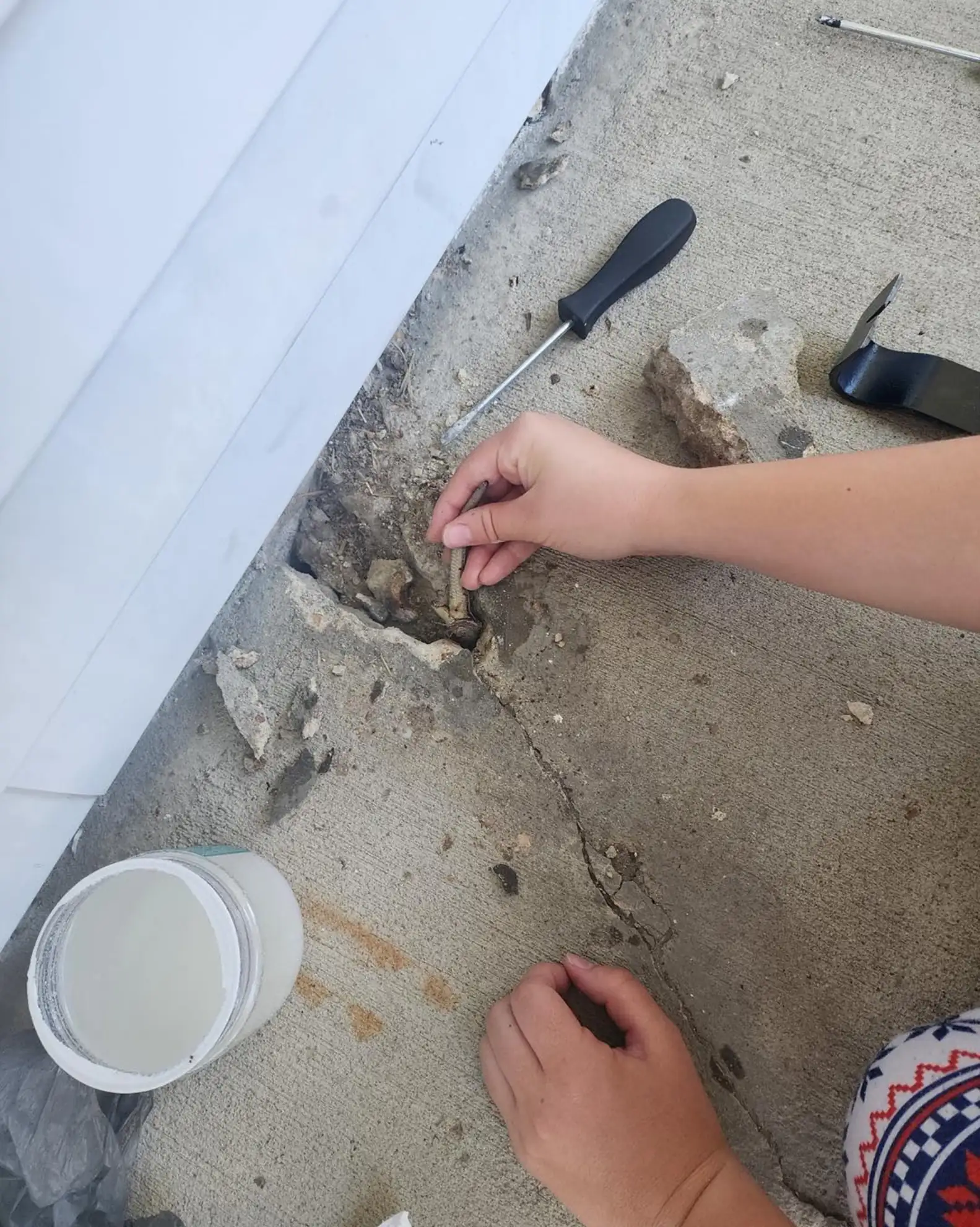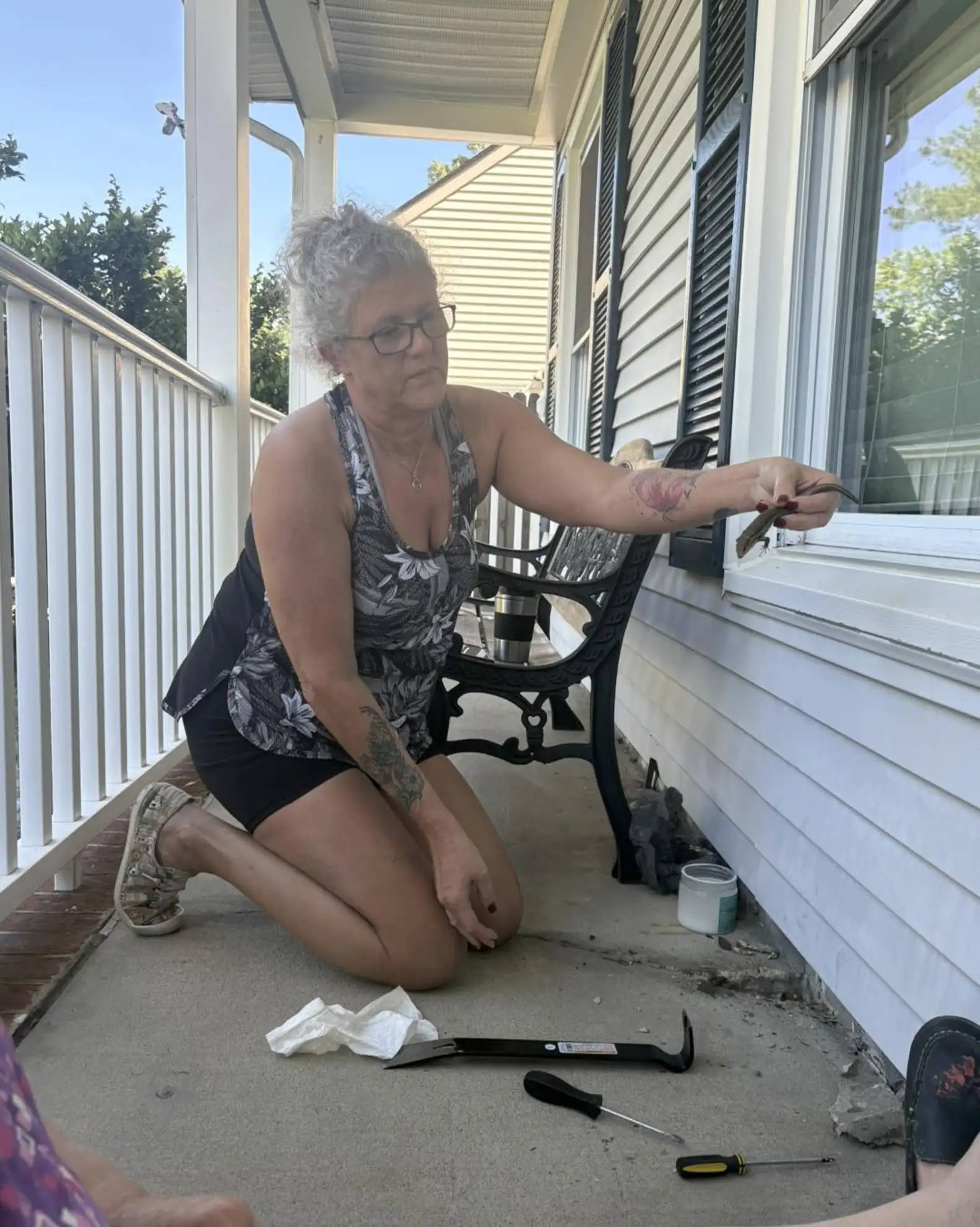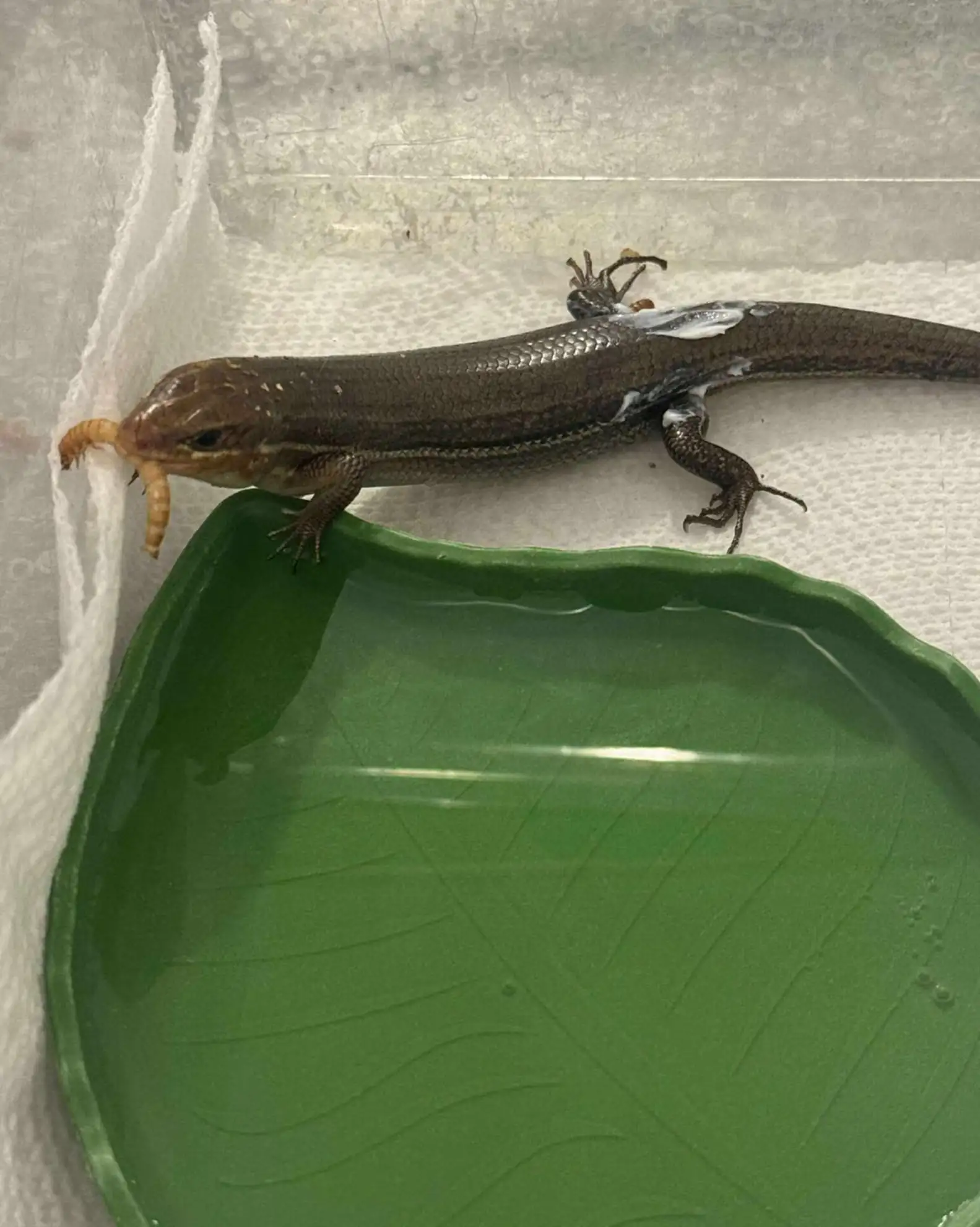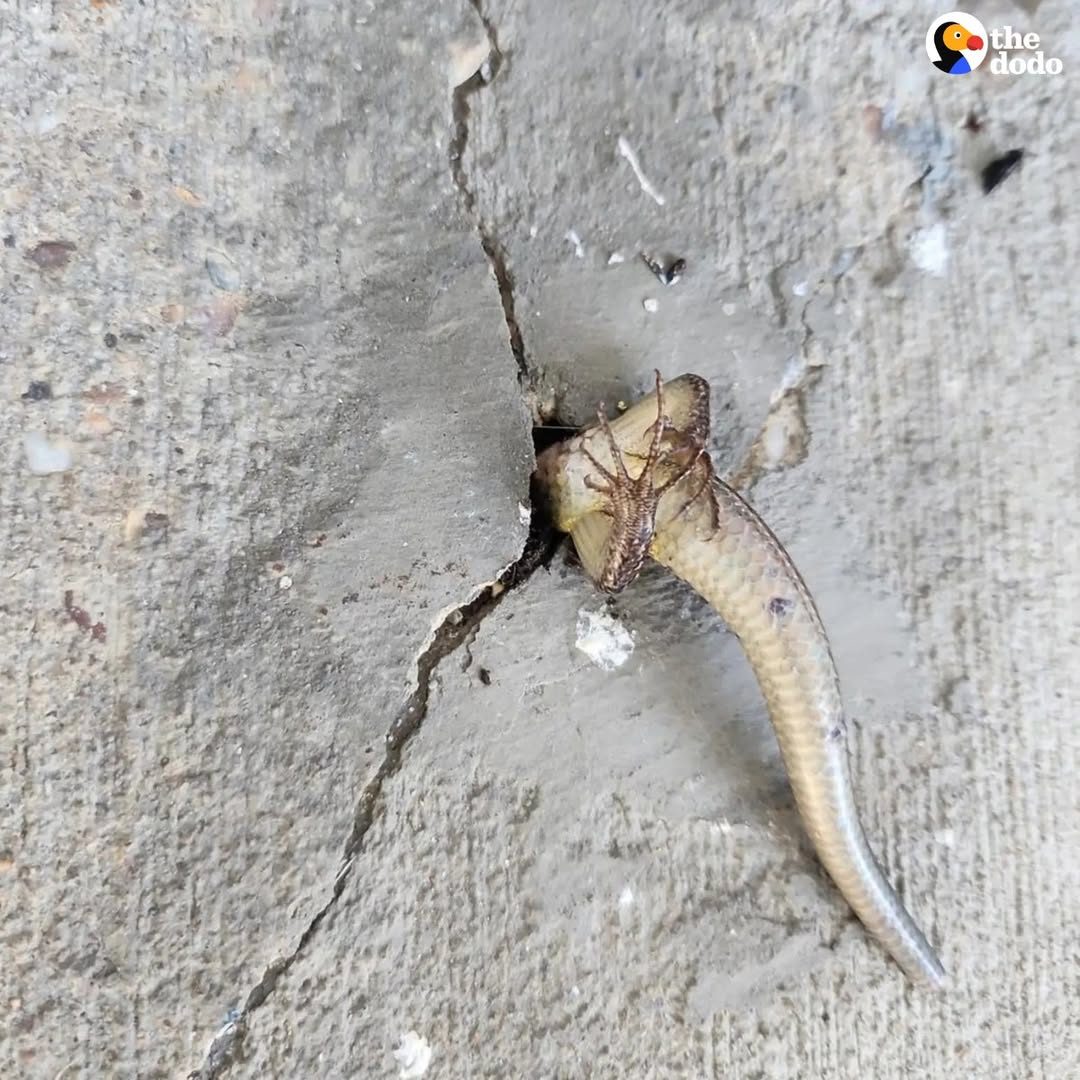Last month, a Texas homeowner, Shawnda Bentley, was in for an unusual surprise when she spotted something strange protruding from a crack in her concrete porch. A small tail and tiny legs were visible, wriggling around. To her surprise, the animal was a skink, which had somehow become wedged in the crack. The homeowner was deeply concerned and decided to call for help from Evelyn’s Wildlife Refuge. What followed was a remarkable rescue operation that took almost two hours and involved a team of dedicated volunteers.
The rescue team, led by Shawnda Bentley, knew this wasn’t a typical situation. Normally, lizards like skinks don’t get stuck in such a way. However, they found the poor creature in a distressed state. Bentley, a senior rehabber, explained that skinks rarely find themselves in these situations. At first, she assumed the lizard was simply sunbathing but soon realized how serious the situation was. “Boy, was he stuck!” Bentley said. This revelation marked the beginning of the arduous rescue process.

The Skink’s Struggle: A Delicate Rescue Operation
Upon closer inspection, Bentley realized that the skink’s tail couldn’t be grabbed, as skinks, like many other lizards, can drop their tails as a defense mechanism when threatened. The idea of pulling on his tail would have resulted in it being lost, which wasn’t an option. Furthermore, Bentley had to ensure that the skink’s legs weren’t damaged in the process, and pulling him could dislocate his hips or break his limbs. It was clear that careful thought and skill would be required to free the skink without causing harm.
The rescue team arrived prepared for the task, armed with tools such as a hammer, crowbar, screwdrivers, and a secret weapon — coconut oil. Slowly, they chipped away at the concrete crack, and once enough space was cleared, they gently applied coconut oil to the skink to lubricate his body. This would make it easier for him to slide out of his entrapment. The process was slow and careful, as the team wasn’t sure where the skink’s head was and wanted to avoid any further harm.
After nearly two hours of careful work, Bentley successfully freed the skink. But it wasn’t over yet. As soon as the skink was out, he latched onto Bentley’s finger and bit her — a natural reaction to being trapped and then handled by strangers. “Well, you know what? That’s okay. I’d be mad, too,” Bentley laughed, understanding that the lizard’s frustration was justified.

Immediate Medical Attention
Unfortunately, the skink, later named Coconut, was not out of danger just yet. His tail had been injured and the tip was lost in the struggle. More concerning was the large gash on his belly, which needed immediate attention to prevent infection. Linda Nichols, a seasoned rehabber at Evelyn’s Wildlife Refuge, expressed concern over the wound’s severity and its potential risk for infection. She also worried that the skink’s spine could have been damaged while it was stuck since the skink had trouble moving its back legs after being freed.
Fortunately, Coconut responded well to both topical and oral antibiotics. Nichols, who took the skink into her care, observed that Coconut was becoming more active and full of energy, which was a positive sign. Remarkably, his tail began to grow back, although it would be shorter than the original.

Coconut’s Recovery: A New Beginning
Coconut, now affectionately known as “Jalapeño Coconut,” has made remarkable progress in his recovery. Despite the initial trauma, the skink has regained his appetite and energy, which is essential for his healing process. Coconut’s recovery was made easier by the loving care he received from Nichols and her team of volunteers, who have been dedicated to his well-being. The skink has now become more active, trying to move around and explore despite his injury, making it necessary for Nichols and a volunteer to assist him during his treatment.
Coconut’s love for food, particularly tiny insects, was likely what got him into trouble in the first place. Skinks, being insectivores, often find themselves wriggling into tight spaces in pursuit of a meal. Nichols theorized that Coconut “underestimated how big the second half of his body is,” which led him to get stuck.
Once Coconut’s wound has fully healed, Nichols plans to release him back into the wild. Skinks, known for forming family-like groups, will be returned to an area where he can reconnect with his community and enjoy the freedom he so richly deserves. “We want to take him back where he has a community and knows the best places to hide and find food,” Nichols said.
Skinks and Their Amazing Defense Mechanisms
Skinks, like many reptiles, possess a unique ability to protect themselves from predators. One of the most fascinating features of skinks is their ability to shed their tails when threatened. This defense mechanism allows them to escape while their detached tail continues to wriggle, distracting predators. The new tail that regrows is functional, though it may be slightly shorter than the original. This ability is crucial for survival, especially when faced with dangerous situations.
Skinks can live in close-knit groups, which helps them stay safe in the wild. By releasing Coconut back to an area with other skinks, he will be able to continue living his life in the safety of his community.
Learn More About Incredible Animal Rescues
The story of Coconut’s rescue is a heartwarming example of the dedication and care that goes into saving animals in need. Shawnda Bentley, Linda Nichols, and their team of volunteers worked tirelessly to free and heal this little skink, and their efforts paid off. Coconut, now recovering well, will soon return to his natural habitat, where he can live freely once again.
For more inspiring stories about incredible animal rescues, check out these articles:
- Man Loses 360 Pounds Naturally, Internet Rallies to Support His Next Step
- Tammy Hembrow’s Bikini Photos Are Stirring Controversy — Here’s Why Everyone’s Talking
These stories highlight the power of community support, compassion, and the resilience of both humans and animals alike.

